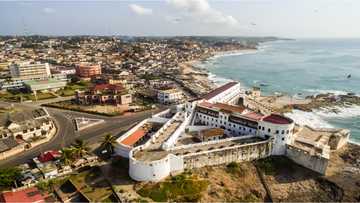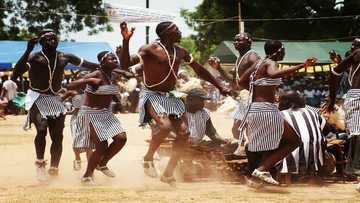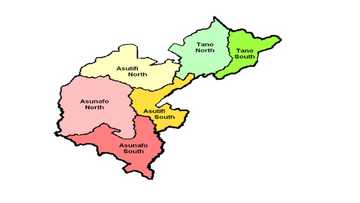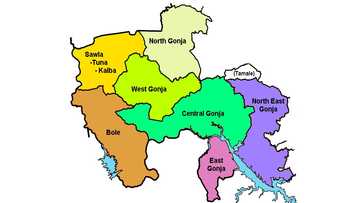List of Western North Region districts and their capitals
Ghana has a regional ascendancy in place for governance effectiveness. The regions are divided into districts, and each district is assigned a capital city. Before 2019, there were ten regions in the country. In 2019, six new regions were enacted through a referendum by people. Western North Region districts are among the newly added administration areas.

Source: Instagram
The new Western North Region fulfils an undertaking made by the New Patriotic Party (NPP) during the 2016 general election. Upon winning the presidential election, President Nana Akuffo Addo established the Ministry of Regional Reorganization which would oversee the implementation of the promise. Here is what you need to know about major towns in Western North Region.
Western North Region districts
The Western North Region is bounded by Ivory Coast's Comoe District to the west, The Central Region to the southeast, Bono East, Bono, Ahafo, and Ashanti to the north. This area receives the highest rainfall in entire Ghana. It has lots of green hills as well as fertile soil. Other than agriculture, small-scale and large-scale gold mining occurs in the region.
This administrative area had a total population of 658,835 people in the 2010 census. It is speculated that the current population is close to a million people. The main ethnic groups in the Western North Region of Ghana are composed of the Sefwis. The main languages spoken in the area include English, French, Akan, and Sefwi.
Main Western Region hospitals that serve the population in the area include Effia Nkwanta Regional Hospital and Bibiani Government Hospital. There are also many local clinics, dispensaries, and other smaller health facilities where people can get medical services.
The area has nine parliamentary constituencies. The number of these representation units is constantly changing. As of now, the Western North Region constituencies include:
- Bia East
- Bia West
- Bodi
- Sefwi-Akontombra
- Sefwi-Wiawso
- Aowin
- Bibiani-Anhwiaso-Bekwai
- Juabeso
- Suaman
How many districts are in Western North Region?
The Western North Region has a total of nine districts. Each of the districts has different population statistics, economic activities, and area. Here is a breakdown of the nine administrative areas:
1. Bia East – Adobokrom
Second, on the list of districts in the Western North Region is Bia East. Originally, this administrative unit was part of the larger Bia District. On June 28th, 2012, Bia District was split to form Bia East. The remaining part of the original was renamed Bia West.
Bia East has Sefwi Adobokrom as its capital town. The administrative unit geographically borders Bormaa District on the East, Asuriafo North District on the northern side, Juabeso on the southern side, and Bia West on the western side. The district capital, Adabokrom, is 420 kilometres to the north of Takoradi.
The population of the area stands at 27,393, with 13,020 females and 14,373 males. As of 2020, the district is said to have over 37,106 people. The main economic activity in the area is agriculture. Crops such as maize and other legumes are grown here. Some dwellers also keep sheep, cattle, goats, and so forth.
2. Sefwi-Wiawso – Wiawso
Sefwi-Wiawso was originally created in 1988 as an ordinary district assembly. On February 29th, 2008, part of it was split off to form the Sefwi-Akontombra District. The remaining part was retained as Sefwi-Wiawso. In March 2012, the unit gained a municipal district assembly status.
The capital town in the administrative city is Wiawso. The district borders Sefwi Bibiani-Ahwiaso-Bekwai to the eastern side, Bodi District to the west, Asunafo South of the Brong Ahafo Region to the north, and Aowin to the south. Population-wise, the area had 139,200 inhabitants in the 2010 census. Currently, it is projected that the district serves as a home to more than 182,510 people.
Sefwi-Wiawso is largely covered by equatorial forests and other commercial tree plantations. The main economic activity in the area is agriculture. Other than producing timber, cocoa, and plantain, Wiawso is also a mining area. It houses the Sefwi Wiawso Municipal Cocoa factory and the Enable Youth 101F Food Processing plant.
3. Aowin – Enchi

Source: Twitter
Aowin is a former district in the larger Western Region of Ghana. It was originally created in 1988 as an ordinary district assembly. Later it was split into two to give birth to the Suaman District in 2017. In 2019, the district moved from being in the Western Region to the newly created Western North Region.
Aowin District has its headquarters in Enchi city. Geographically, it shares common boundaries with Jomoro, Sefwi-Wiawso, Juabeso, and Wassa Amenfi districts. To the west, it borders Cote d'Ivoire. Aowin has an area of 2,638 square kilometres. These square kilometres are home to over 154,661 people.
The main economic activity in Aowin is Agriculture. The practice is supported by two rivers named Tano and Bia, along with uncountable tributaries that drain through the district.
4. Bodi – Bodi
Bodi is also among the Metropolitan, Municipal, and District Assemblies in Ghana. Originally, the governance unit was part of the large Juaboso-Bodi District. The district was carved from Juaboso with the Li 2020. It was inaugurated on June 28th, 2012.
Bodi has a total land size of 662.404 square kilometres. It shares borders with Juaboso District to the northern side, Sefwi Wiawso to the western side, Suaman to the east, and Sefwi Akontombra to the southern side.
5. Bia West – Essam
Another district located in the Western North Region of Ghana is Bia West. The administrative unit was a part of the larger Bia district. It was carved by Legislative Instrument (Li) 2014 and officially made a district on June 28th, 2012.
By then, the district was located in the bigger Western Region. In 2019, it was part of the new Western North Region. Bia West's capital town is Sefwi Essam. The capital town is located 20 kilometres from Kumasi and 420 kilometres to the northwest of Sekondi Takoradi.
Bia West shares boundaries with Bia East to the East, The Republic of Cote d'Ivoire to the west, and Juaboso to the south. According to the 2010 housing and population census, 88,939 people were living in the area.
Out of the number, 43,222 were female and 45,717 males. Currently, it is estimated that Bia West has 111,355 people. This district is known for producing Cocoa, Timber, Palmnut, Chocolate, and Plantain. It houses A rice factory and a Youth Food processing industry.
6. Sefwi Akontombra – Sefwi Akontombra

Source: Twitter
Sefwi Akontombra is another district found in the Western North Region. Originally, the governance unit was part of the large Sefwi-Wiawso district in 1988. Part of the large district was broken up to become Sefwi Akontombra on February 29th, 2008.
Akontombra has its capital town as Sefwi Akontombra. It shares borders with Sefwi Wiawso to the east, Juaboso to the north, Aowin to the southeast side, and Amenti to the southwest side. The district covers an area of about 1,120 square kilometres.
Sefwi Akontombra is a known producer of Cocoa, Cassava, Oil Palm, Rice, Plantain, and Timber. The district houses the Common User Rice Processing Facility and Sefwi Akontombra rice processing industry.
7. Juaboso – Juaboso
Juaboso is another district in Western North Region. Originally, it was part of the Juaboso-Bodi District. It was split off and renamed Juaboso in 2012. The district has its capital town as Juaboso.
The district is further divided into sub-districts which include Kofikrom-Proso, Boinzan, Benchema-Nkatieso, and Asempaneye. Geographically, Juaboso lies to the north of Bia East, Bia West, and Asunafo North Municipal Districts. Its eastern neighbours include Bodi and Asunafo South Districts.
The area also shares borders with Suaman to the south and La Cote d'Ivoire to the west. Juaboso is 360 kilometres to the northwestern side of Takoradi, 65 kilometres to the northwest of Wiawso, and 225 kilometres to the southwest of the Kumasi city. The main economic activity of the more than 58,435 people who live in the area is agriculture. Juaboso endowments include Cassava, Gold, Cocoa, Timber, Plantain, and Arable Land.
8. Sefwi Bibiani-Anhwiaso-Bekwai – Bibiani
Sefwi Bibiani-Ahwiaso-Bekwai is among the nine districts in Western North Region. Originally, the area was created as an ordinary district assembly in 1988. In 2012 March, it was upgraded to a municipal district assembly. Its name didn't change during the upgrade.
The municipal district shares boundaries to the north with Atwima district in the larger Ashanti Region. To the eastern side, it borders the Upper Denkyira District of the Central Region and Amansie East District of the Ashanti region. On the south and west, it shares borders with Wassa Amenfi and Sefwi Wiawso Districts, respectively.
Sefwi Bibiani-Ahwiaso-Bekwai covers an area of 873 square kilometres and houses a population of 80,855 males and 63,417 females. As of 2020, it is projected that the area has 160,844 people.
The municipal district is mainly composed of equatorial rainforests and deciduous forests, which provide timber to Ghanaians. The economy of the district is mainly run by agriculture. Black pepper farming, aquaculture, and snail keeping are some of the non-traditional agricultural practices carried out in the area.
9. Suaman – Dadieso

Source: Twitter
Suaman District was originally part of the then Aowin-Suaman District in 1988. On June 28th, 2012, part of Aowin-Suaman was split off to create Suaman District. The remaining part was renamed Aowin District.
The Suaman Municipality has its capital town as Dadieso. The district shares boundaries to the south with the mother district Aowin. To the north, it borders Bodi while to the East Sefwi Akontombra. To the west, Suaman shares a border with Ivory Coast.
The population of the municipality as of 2010 stood at 20,529, with 9,883 females and 10,646 males. As of 2020, 27,832 people are thought to reside in the area. The main Suaman endowments are Cocoa, Arable Land, Plantain, Stones, and Mushrooms. The area houses the Suaman Agro-Processing factory.
The above are Western North Region districts. The nine municipalities are agriculturally endowed. The climate favours the farming of different kinds of crops. Some of the districts also produce gold.
Yen.com.gh published a list of 16 regions in Ghana and their capitals. They are divided into districts to make administration easier.
The populous regions in Ghana is the Greater Accra Region. Others include Central, Eastern, Ashanti, and Northern.
Source: YEN.com.gh









